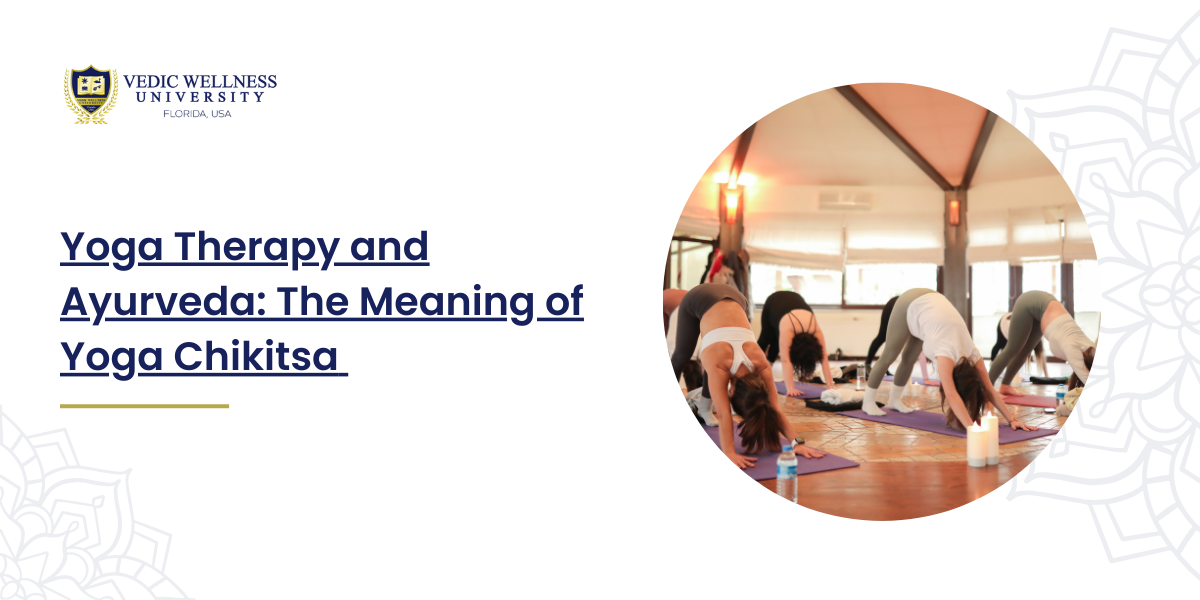क्ताहारविहारस्य युक्तचेष्टस्य कर्मसु।
युक्तस्वप्नावबोधस्य योगो भवति दुःखहा।।
(Yuktahara Viharasya Yuktacheshtasya Karmasu,
Yuktasvapnavabodhasya Yogo Bhavati Duhkhaha.)
“For one who is moderate in eating and recreation, balanced in work and regulated in sleep, Yoga destroys all sorrow.” – Bhagavad Gita 6.17
Introduction
Yoga and Ayurveda are two interconnected branches of ancient Indian wisdom that provide a holistic approach to health and well-being. In recent years, there has been a growing global interest in these ancient sciences as more people seek natural ways to achieve balance and harmony in their lives. Central to this holistic approach is Yoga Therapy, known in Sanskrit as Yoga Chikitsa. This blog will explore the meaning of Yoga Therapy, its benefits, and its integration with Ayurveda to provide a comprehensive understanding of health.
Yoga Therapy focuses on using yoga practices as a therapeutic tool to address physical, mental, and emotional imbalances. When combined with Ayurveda, the science of life, it creates a powerful synergy that promotes healing and well-being. This blog will delve into the benefits of yoga therapy, provide a detailed yoga therapy definition, and highlight the health benefits of yoga as understood through the lens of Ayurveda.
The Principles of Ayurveda and Their Connection to Yoga Therapy
Ayurveda, the ancient Indian system of medicine, is based on the principles of balance and harmony within the body, mind, and spirit. According to Ayurveda, health is achieved when there is a balance between the three fundamental energies or Doshas—Vata (air and space), Pitta (fire and water), and Kapha (water and earth). An imbalance in these doshas leads to illness, and the goal of Ayurvedic practices, including Yoga Therapy, is to restore balance.
Basic Principles of Ayurveda and Their Relevance to Yoga Therapy
- Dosha Balancing: The core principle of Ayurveda is the balancing of the three doshas. Yoga Therapy incorporates specific asanas (postures), pranayama (breathing exercises), and meditation techniques to balance these doshas. For example, gentle and grounding yoga practices can pacify Vata, while cooling and calming practices are beneficial for Pitta, and invigorating, dynamic practices help balance Kapha.
- Mind-Body Connection: Ayurveda emphasizes the connection between the mind and body, recognizing that mental stress can manifest as physical ailments. Yoga Therapy works on this principle by using yogic practices to calm the mind, reduce stress, and promote emotional stability, thereby contributing to overall well-being.
- Personalized Treatment: Ayurveda advocates for personalized treatment plans based on an individual’s unique constitution or Prakriti. Similarly, Yoga Therapy is not a one-size-fits-all approach; it tailors the practices to the individual’s needs, health conditions, and goals, making it a highly effective form of therapy.
By integrating these principles, Yoga Therapy serves as a bridge that connects physical health with mental and spiritual wellness, providing a holistic approach to healing.

Understanding Yoga Therapy: Definition and Benefits
Yoga Therapy is a specialized field within the broader discipline of yoga that focuses on adapting traditional yoga practices to address specific health conditions. Unlike general yoga classes, Yoga Therapy is individualized, taking into account a person’s physical, mental, and emotional needs. The aim is to use yoga as a therapeutic intervention to promote healing, prevent illness, and enhance overall well-being.
Yoga Therapy Definition and Its Unique Approach
- Personalized Yoga Practice: The primary aspect of Yoga Therapy is personalization. It involves assessing an individual’s health status, identifying imbalances, and creating a customized yoga program that includes asanas, pranayama, meditation, and lifestyle modifications. This approach makes it distinct from regular yoga classes that may not address specific health concerns.
- Combining Yoga and Ayurveda: In the context of Ayurveda, Yoga Therapy takes into consideration an individual’s dosha constitution. For example, a Pitta dominant person may benefit from cooling and calming yoga practices, while a Kapha dominant person may require more dynamic and stimulating postures to balance their energies.
- Holistic Healing: Yoga Therapy is not limited to physical health; it also addresses emotional and mental well-being. By integrating yogic practices like pranayama and meditation, it helps in reducing stress, anxiety, and depression, fostering a sense of inner peace and balance.
Health Benefits of Yoga Therapy
The health benefits of yoga are well-documented and cover a wide range of physical, mental, and emotional aspects.
- Physical Benefits: Yoga Therapy improves flexibility, strength, and balance. It also supports the functioning of vital organs, enhances circulation, and aids in the management of chronic conditions such as arthritis, hypertension, and diabetes.
- Mental Benefits: The practice of yoga helps in reducing stress, anxiety, and depression. Through breathing exercises and meditation, Yoga Therapy calms the mind, promotes mental clarity, and enhances concentration and focus.
- Emotional Benefits: Yoga Therapy fosters self-awareness and emotional resilience. It encourages mindfulness and helps individuals develop a positive outlook towards life, promoting overall emotional health.
Categories of Yoga Therapy Practices in Ayurveda
Yoga Therapy can be broadly categorized into several types based on the goals of the practice and the specific needs of the individual. These categories help practitioners understand how to tailor their approach for maximum benefit.
1. Therapeutic Yoga for Physical Health:
- Asana-Based Therapy: This form of therapy focuses on specific yoga postures that target different parts of the body. For instance, forward bends and twists can help in improving digestion and reducing lower back pain, while gentle inversions can boost circulation and lymphatic drainage.
- Benefits: Enhances flexibility, builds strength, and improves the overall functioning of bodily systems. It is particularly effective for managing chronic conditions like arthritis, osteoporosis, and back pain.
2. Breathwork and Pranayama for Respiratory Health:
- Pranayama Practices: Pranayama is the practice of controlled breathing techniques that help in balancing the life force (prana) within the body. Techniques like Nadi Shodhana (alternate nostril breathing) and Kapalabhati (skull shining breath) are commonly used in Yoga Therapy.
- Benefits: Improves lung capacity, reduces stress, enhances mental clarity, and helps in managing respiratory disorders such as asthma and bronchitis.
3. Meditation and Mindfulness for Mental Health:
- Meditative Practices: Meditation is an integral part of Yoga Therapy that focuses on mental relaxation and emotional stability. Techniques like Yoga Nidra (yogic sleep) and Dhyana (focused meditation) are utilized for this purpose.
- Benefits: Reduces anxiety and depression, improves emotional resilience, enhances cognitive functions, and fosters a sense of inner peace and well-being.
4. Integrative Therapy for Holistic Health:
- Combining Yoga and Ayurveda: This approach integrates yoga postures, pranayama, meditation, diet, and lifestyle changes to create a comprehensive healing plan tailored to the individual’s needs.
- Benefits: Offers a balanced approach that addresses all dimensions of health—physical, mental, and spiritual. It is particularly effective for those looking for long-term wellness solutions.
Vedic Wellness University: Promoting Yoga Therapy and Ayurveda
Vedic Wellness University (VWU) is at the forefront of promoting Yoga Therapy and Ayurveda as essential components of holistic wellness education. With a focus on integrating ancient Vedic knowledge with modern practices, VWU offers a wide range of courses that cater to students from around the globe.
Courses Offered by Vedic Wellness University
- Diploma in Yoga Therapy:
This course provides an introduction to Yoga Therapy definition, its principles, and practices. It is ideal for beginners who want to explore the therapeutic benefits of yoga.
- Graduate and Postgraduate Programs in Ayurveda and Yoga Therapy:
These programs offer a deeper understanding of Ayurveda and Yoga Therapy. They cover the health benefits of yoga, dosha balancing, and personalized yoga practice for various health conditions.
- PhD in Integrative Health Sciences:
For advanced learners, this program provides an opportunity to conduct original research on the integration of yoga and Ayurveda, contributing to the growing field of integrative health.
- Associate Programs for Partner Institutions:
VWU collaborates with institutions worldwide to offer specialized courses in Yoga Therapy and Ayurveda, promoting the ancient Indian sciences to a broader audience.
How to Enroll in Vedic Wellness University Courses
Interested students can visit the VWU website, explore the courses, and select the program that best suits their interests and career goals. With a user-friendly enrollment process, flexible learning schedules, and access to expert faculty, VWU ensures a seamless educational experience for all its students.
Conclusion
Yoga Therapy and Ayurveda, with their deep roots in ancient Indian philosophy, offer a comprehensive approach to health and wellness that is both timeless and relevant. As the world moves towards natural and holistic methods of healing, the significance of Yoga Therapy is becoming more widely recognized. By understanding the yoga therapy definition and its integration with Ayurveda, individuals can harness the full potential of these ancient sciences to achieve balance, harmony, and well-being.
Vedic Wellness University is dedicated to spreading this ancient wisdom through its diverse range of courses, making


